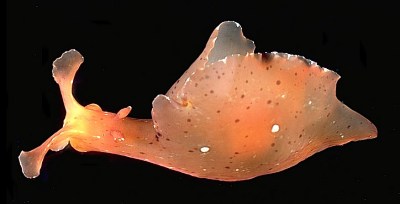
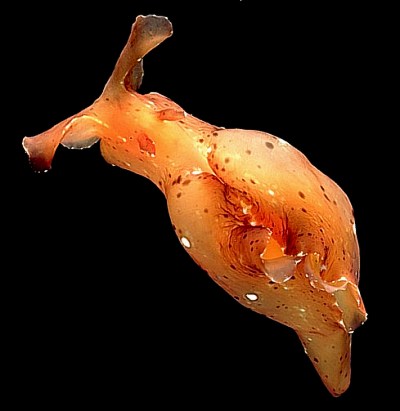
Aplysia sagamiana
Baba, 1949
Order: ANASPIDEA
Superfamily: APLYSIOIDEA
Family: Aplysiidae
DISTRIBUTION
Japan, eastern Australia.
PHOTO
Fly Point, Port Stephens, New South Wales, 10-15m, 50mm long, October 1980. PHOTO: Bill Rudman.
This beautiful little species was originally reported from Sagami Bay, Japan. This specimen from Eastern Australia is almost identical to the illustration published in Baba's Opisthobranchs of Sagami Bay. It is apparently quite uncommon as this is the only record I know of this animal from Australia.
See the General Topics List for more information on Sea Hares.
Reference:
• Baba, K. (1949) Opisthobranchia of Sagami Bay. Iwanami Shoten, Tokyo. 211pp + pls.
Rudman, W.B., 1999 (May 3) Aplysia sagamiana Baba, 1949. [In] Sea Slug Forum. Australian Museum, Sydney. Available from http://www.seaslugforum.net/find/aplysaga
Related messages
Another large seahare from New Zealand
April 24, 2007
From: Ross Armstrong
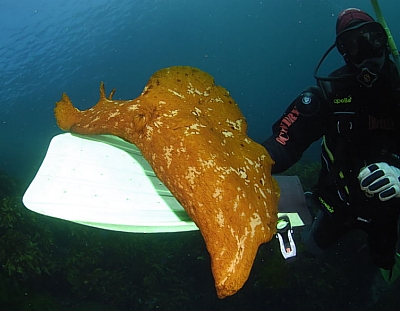
Dear Bill
Thought you might be interested in knowing we found another large seahare at the Knights today. Just outside of Rikoriko cave where we found the first one we sent you [message #14048 ]. Suspect that is just a coincidence.
Poor Knights Islands, Northland, New Zealand. South Pacific Ocean. Depth: 13 metres. 22 April.2007. Cave entrance. Photographer: Ross Armstrong
What is interesting is that we did not see the white patch on the side of it like the last two had. The fin is 61cm long.
Best regards
Ross
ross@oceanwildlife.com
Armstrong, R., 2007 (Apr 24) Another large seahare from New Zealand. [Message in] Sea Slug Forum. Australian Museum, Sydney. Available from http://www.seaslugforum.net/find/19839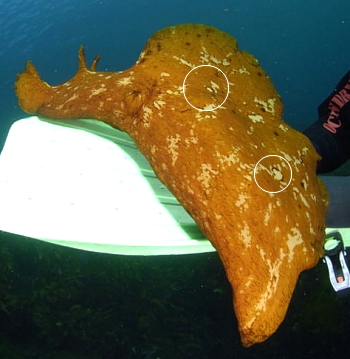
Thanks Ross,
The white spots with a dark brown ring are in fact present - but not quite as noticeable in this specimen. It certainly has similarities to the large Aplysia extraordinaria from eastern Australia but I can't recall a specimen with these distinctive brown-ringed white spots, and your animals seem to have no interest in swimming, which is a characteristic of A. extraordinaria. The only specimen I have seen in eastern Australia with these spots, is the small, apparently juvenile, animal I have on the A. sagamiana Fact Sheet.
Best wishes,
Bill Rudman
Re: Aplysia sagamiana from Poor Knights Ids, NZ.
April 24, 2006
From: Ross Armstrong
Concerning message #16368:
I spoke to my friend again about the sea hare he saw swimming. While he did see one swimming it was not a very large sea hare like the ones we photographed. We both believe it was probably a different species.
Ross Armstrong
ross@oceanwildlife.com
Armstrong, R.W., 2006 (Apr 24) Re: Aplysia sagamiana from Poor Knights Ids, NZ.. [Message in] Sea Slug Forum. Australian Museum, Sydney. Available from http://www.seaslugforum.net/find/16408Thanks Ross,
Nice to clarify that
Best wishes,
Bill Rudman
Re: Aplysia sagamiana from Poor Knights Ids, NZ.
April 18, 2006
From: Ross Armstrong
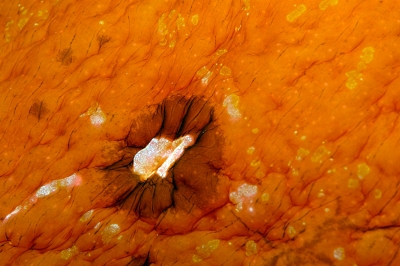
Concerning message #16368:
Dear Bill,
Thanks for the clarification of the species.
I have attached a close-up of the spot taken by Diane.
Regards
Ross
ross@oceanwildlife.com
Armstrong, R., 2006 (Apr 18) Re: Aplysia sagamiana from Poor Knights Ids, NZ.. [Message in] Sea Slug Forum. Australian Museum, Sydney. Available from http://www.seaslugforum.net/find/16382Aplysia sagamiana from Poor Knights Ids, NZ.
April 18, 2006
From: Ross Armstrong
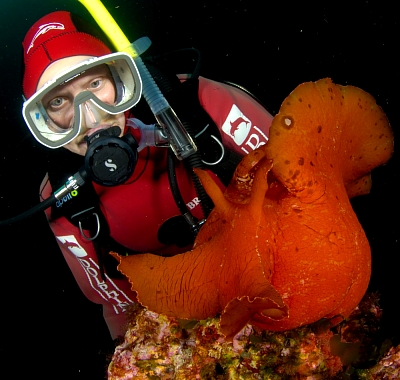
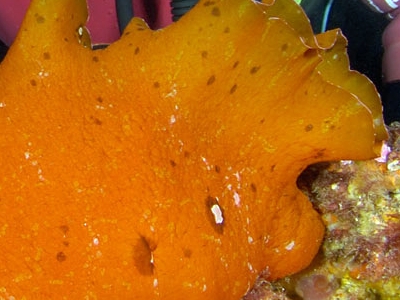
Dear Bill,
Diane and I found another "giant" seahare at the Poor Knights on Friday. The pictures showing the diver (Diane) were taken with a fisheye lens so there is a little bit of perspective distortion. It was not quite as large as the seahare we found in Rikoriko cave but still pretty large, I would estimate it to be bigger than 350 mm. I found it amoung some kelp on a wall just below where the picture was taken. I moved it to this place to get some better pictures. It did not seem too concerned and continued feeding on some sea lettuce (Ulva sp.) as shown in Diane's photo. I also tried to see if it would swim by releasing it in open water - a bit questionable in a marine reserve but hopefully with the right (scientific) purpose in mind. Unfortunately it shows not the slightest sign of swimming and just sunk slowly. We have now seen three seahares that were of a similar size and colouration. I have not seen any of them swim. They all had distinct white spots on their sides which you can see in the third picture.
Locality: Poor Knights Islands, 10 m, Northland, New Zealand, South Pacific Ocean, 14 April 2006, Rocky reef wall. Length: > 350 mm. Photographer: Ross Armstrong.
Best regards,
Ross Armstrong
ross@oceanwildlife.com
Armstrong, R.W., 2006 (Apr 18) Aplysia sagamiana from Poor Knights Ids, NZ.. [Message in] Sea Slug Forum. Australian Museum, Sydney. Available from http://www.seaslugforum.net/find/16368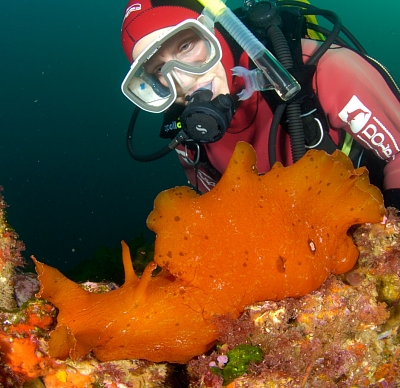
Dear Ross,
Since your earlier two records of this species [messages #14048, #14063] from New Zealand I have had a photo from Anne Gilmore [#15867] of what must be the same species, and which I suggested may be Aplysia sagamiana. Her animal was quite a bit smaller than your specimens and so I had no difficulty in identfying it with specimens I have from eastern Australia which look very like A. sagamiana from Japan.
As you say, the white spots, encircled with a brown ring, are a very distinctive feature of your animals and are also present in those smaller ones I have considered to be A. sagamiana. Despite your friend saying he saw one of your large sea hares swimming, your experiences suggest it doesn't. From your photos here, it also has the parapodia joining posteriorly quite high above the body. I am pretty sure now that it is not A. extraordinaria. Baba described A. sagamiana as a 'small Aplysia' growing to about 70 mm, but he had information on only a few specimens so it is possible he was looking at juveniles of a much larger species. At this stage A. sagamiana is the only species with these distinctive white spots surrounded by dark brown rings, so I will tentatively identify your animals as that species.until we know more about it from Japan.
Best wishes,
Bill Rudman
Aplysia sagamiana at the Poor Knights, New Zealand
February 18, 2006
From: Ann Gilmore
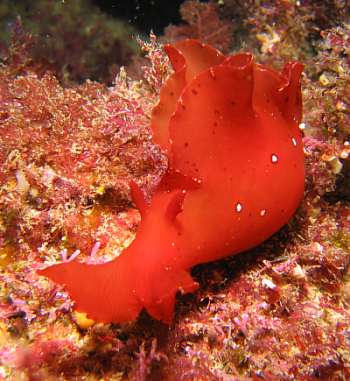
Hi,
This seahare was found in approx 19 metres of water at the Middle Arch divesite of the Poor Knights marine reserve in New Zealand. It is approximately 100 mm long, and was on the substrate seen in the photo (not moved). The colour is as it was. I saw only the one.
This is a sea hare which I haven't been able to find in my ID books, and which is different from the varieties I and my diving companions have previously seen at the Poor Knights.
This photo was taken 30th January 2006. Water temperature that day was approximately 19 degrees celcius.
Locality: Middle Arch Poor Knights Islands, 19 metres, New Zealand, Pacific ocean, 30 January 2006, rocky, with heavy encrustation of algal etc growth. Length: 100 mm. Photographer: Ann Gilmore.
Your help in identifying it would be most appreciated.
Ann Gilmore
ann@nzl.biolabgroup.com
Ann Gilmore, 2006 (Feb 18) Aplysia sagamiana at the Poor Knights, New Zealand. [Message in] Sea Slug Forum. Australian Museum, Sydney. Available from http://www.seaslugforum.net/find/15867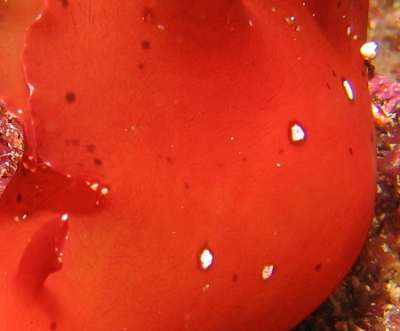
Dear Ann,
This is an interesting find. I have only seen this once before - at Port Stephens in eastern Australia. I have identfiied as Aplysia sagamiana, a species known only from Japan except for your specimen and mine from Port Stephens. The white spots on the parapodia with a dark brown ring seem to be characteristic.
I wondered before if it was a strange colour form of a more common species, but I can't think what that could be. What ever it is, so few records of it from anywhere suggest it is quite a rare species or else we aren't looking in the right place. As far as I know, this is a new record from New Zealand.
Best wishes,
Bill Rudman
Re: Aplysia extraordinaria from New Zealand
June 15, 2005
From: Ross Armstrong
Dear Bill,
In answer to your question [message #14048]: We have now seen three or four of these large sea hares at the Poor Knights but have never seen any of them swimming. Even picking them up has not caused them to swim. However, our friend Glenn Edney did tell me that he has seen one swimming.
Regards
Ross Armstrong
ross@oceanwildlife.com
Armstrong, R.W., 2005 (Jun 15) Re: Aplysia extraordinaria from New Zealand. [Message in] Sea Slug Forum. Australian Museum, Sydney. Available from http://www.seaslugforum.net/find/14063Note added 17 April 2006: This is probably A. sagamiana
Thanks Ross,
Not all sea hares swim, but A. extraordinaria certainly does, so its another good clue that I have correctly identified this animal.
Best wishes,
Bill Rudman
Aplysia extraordinaria from New Zealand
June 14, 2005
From: Ross Armstrong
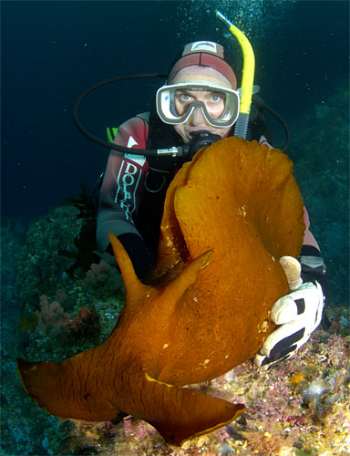
Dear Bill,
Diane and I found this seahare inside Rikoriko Cave at the Poor Knights.
Locality: Poor Knights Islands, Northland, New Zealand. South Pacific Ocean. Depth: 13 metres. Length: approx 40+ cm. 10 and 11 June 2005. Cave entrance. Photographer: Ross Armstrong
We assume it is Aplysia extraordinaria and definitely the largest specimen we have seen. We saw and photographed it on two consecutive days. Both times it did not swim, even when we moved it to a better place to photograph. Both pictures are with a fisheye lens which tends to distort the size of subjects close to the lens. However, Diane's hand gives a reasonable indication of the actual size.
Best regards
Ross Armstrong
ross@oceanwildlife.com
Armstrong, R.W., 2005 (Jun 14) Aplysia extraordinaria from New Zealand. [Message in] Sea Slug Forum. Australian Museum, Sydney. Available from http://www.seaslugforum.net/find/14048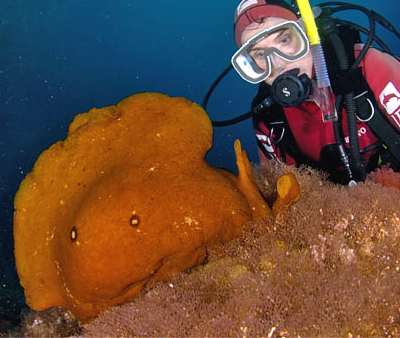
Note added 17 April 2006: This is probably A. sagamiana
Dear Ross,
This is certainly one large Sea Hare! Because of its size I assume it is A. extraordinaria, which is probably the same as A. gigantea. It would be interesting to know if you have ever seen one of these animals swimming , or know someone reliable who has.
Best wishes,
Bill Rudman
